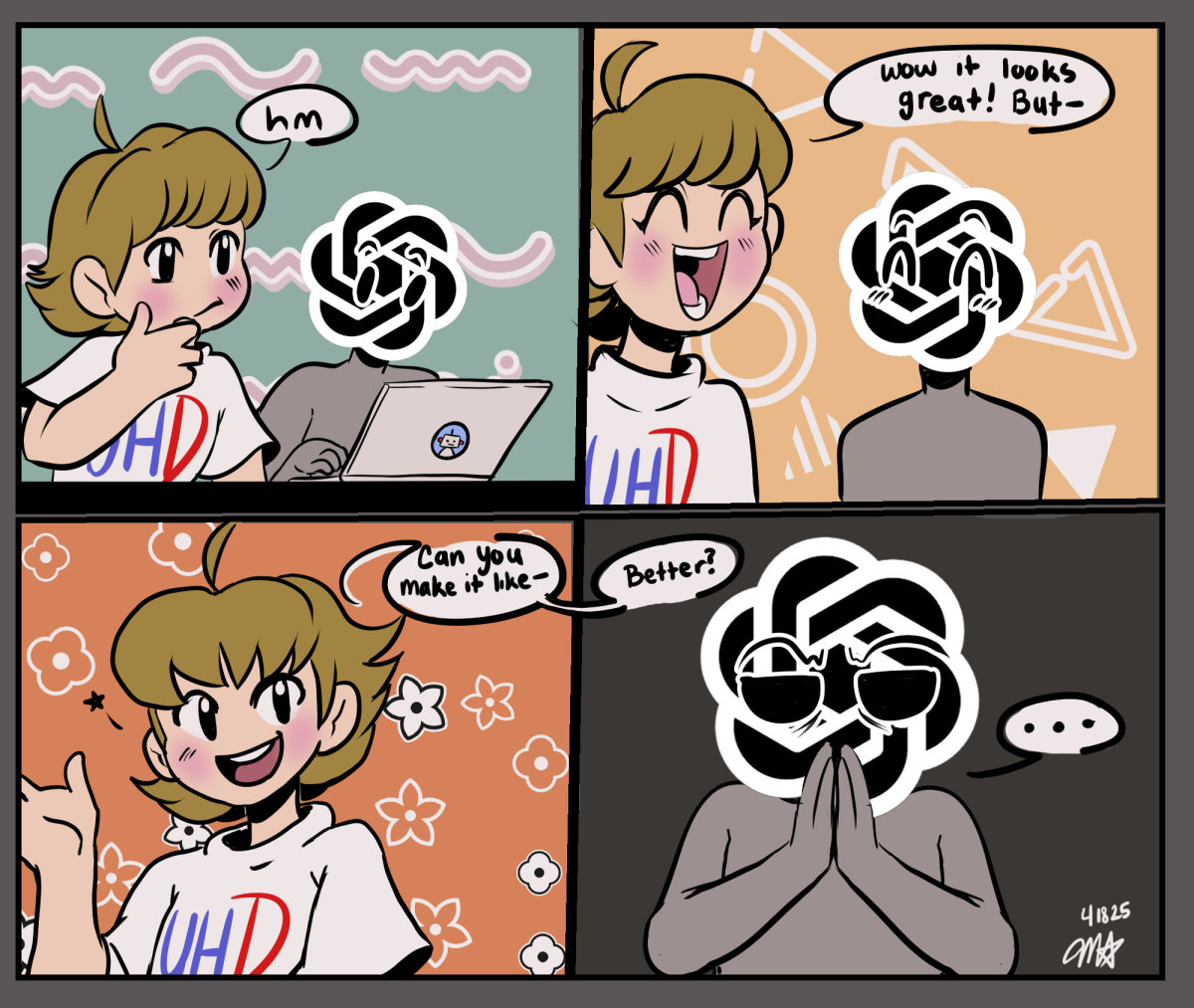Artificial intelligence is moving into higher education, and some UHD professors are testing how it can be used as a learning tool instead of a shortcut.
The main concern most educators have with AI is the negative impact it has not only on plagiarism and cheating, but most detrimentally on student learning. A 2025 Campbell University report by researcher David Mulford found 86 percent of students use AI in their studies, with 54 percent using it weekly and nearly one in four using it daily. The concern is that relying heavily on AI to generate ideas, expand on them, or even write first-draft essays may hinder students’ ability to develop essential writing and comprehension skills independently.
However, when used ethically and responsibly, AI can be a great tool to expand student learning. When conducting research, AI can be a great tool to reiterate a complex topic, such as a theory, into something more comprehensible. When given an original thesis and its following counterpoints, AI could be used as an editor to help you arrange your already developed essay in a way that flows better and makes your essay more comprehensive for the reader.
So there are advantages and pitfalls to AI usage that both professors and students are learning to navigate in the educational field.
Here at UHD, some professors are at the forefront of this new era of learning, experimenting with the integration of AI into their classrooms and coursework.
Dr. Giuliana Lund is an associate professor of English at UHD, where she teaches a technology and literature class, among other courses. Lund is one of the few professors who actively utilize and encourage AI usage throughout her courses. From conversations and assignments that require AI input to learning about the inner workings and makeup of artificial intelligence, her main goal is for students to be educated about the full range of capabilities and faults of AI.
“I think it is natural that students are going to experiment with AI one way or the other. So it’s much better if students are exposed to AI in a constructive way where they can understand how AI really functions, what its potential is, what its pitfalls are, and that includes issues of public ethics and personal responsibility,” remarked Lund.
While acknowledging that her course technology and literature was easier to integrate AI usage due to the course topic, she also argues, “AI literacy should be incorporated across the university curriculum. I think it’s something that freshmen should be exposed to and that some of the courses within the majors should include because whatever field you’re going into in the future, students need to understand and appreciate how AI is going to impact that field.”
One positive outcome to come from this AI integration, Lund states, is overall student engagement and excitement in the course. She expressed how students at UHD are “sometimes disadvantaged compared to other universities or other parts of the country as far as access to technology and access to information about artificial intelligence,” and how gaining knowledge and understanding about this topic, whether they are hopeful about it or against it, can feel empowering to students.
The most important lesson Lund hopes students take from learning about and with AI is “how to really appreciate what the human brings to the equation. What is the value that the students’ thoughts, ideas, and voice bring that will maintain their relevance and value into the future and not be wiped away by increasingly smart and fast AI?” In her class, students are learning not only how to use AI as a learning tool but also its limitations, particularly its unreliability due to its generative nature. If it doesn’t know the answer to a question, it will simply generate one as truth.
This sentiment is echoed by another professor who has been experimenting with integrating AI into her classes. Dr. Theresa Case is a professor of history here at UHD who teaches a historical research and writing course. In this class, students explore the craft of being a historian, examining what goes beyond data collection and evidence gathering, and how historians’ work translates into an AI-driven world.
Much like Lund, Case’s answer seems to lie in educating her students on the topic of artificial intelligence. Throughout the year, she includes a plethora of projects that explore not only the discourse on AI but also utilize it as a tool to explore its helpful and harmful capabilities. She wants students to consider the extent to which AI changes or affects the historians’ craft.
Case notes “Most of the historical record of humanity is not digitized. So most of the stuff that’s out there to examine to write history with is not digitized, so it’s not something AI would be able to vacuum up like it does other subjects.”
One project she implemented was having her students research an under-studied topic, like Texas Labor Day, for example, where there aren’t very many secondary sources available online, to practice the art of finding original evidence and crafting the story found there.
While Case does highlight the usefulness of AI for different instances like getting through mountains of research, drawing up conclusions from otherwise pages of data, or even generating counterarguments to consider when writing, she also heavily emphasizes the importance of double-checking every answer given when using AI due to its generative aspects.
One way she clearly shows the pitfalls of AI is by conducting a project in which she has her students use AI to try to generate a bibliography for a certain topic. Then, as a class, they will sit and fact-check together to see how, while sometimes the AI does in fact include some useful sources, it also equally generates non-existent sources that result from a conglomerate of different sources online.
This exercise seems to be the most impactful in driving home Case’s main takeaway, which is, “You always want to be the person in charge of the AI, really guiding it, having the expertise to be able to fact-check and make sure it’s taking you in a good direction.”
While both of these professors have taken to weaving AI as a tool in their classes, they are definitely outliers among their peers. While there is no campus-wide AI policy at UHD, a new initiative has recently been introduced, requiring every professor to include a clear and distinct AI policy in their syllabus. Whether that be AI integration or AI resistance, it has been completely left to the discretion of the professors.
Although AI appears to be rapidly evolving, UHD has been making deliberate efforts to adapt to this technology and learn how to effectively integrate AI capabilities into the classroom while maintaining a productive and thriving learning environment for its students. Some of these efforts include the Center for Teaching and Learning Excellence, which hosts professional development, workshops, and key speakers in the field to educate professors on AI. Another way UHD is preparing for AI in a learning environment is that in the last year, a task force of professors has been meeting to discuss AI integration. These are just a few ways in which UHD is working to foster the best learning environment possible for its students.
The integration of AI in higher education is a fine line that requires a balance between embracing the future and maintaining a rigorous academic environment for students. Professors like Lund and Case are showcasing how AI can be a powerful tool when guided by clear policies and ethical frameworks. As universities across the nation grapple with this new technology, it seems that those that focus on AI literacy as opposed to prohibition are giving their students a competitive advantage in an increasingly digital world.






